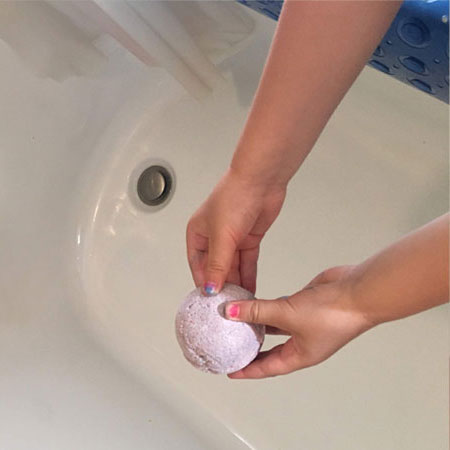
Bath Fizzies
- Challenging
- Messy
- 30 Minutes + 2 Days for Drying
- Indoor or Outdoor
You Will Need
1 large mixing bowl
Spoon
1 cup baking soda
½ cup cornstarch
½ cup Epsom salts
4 tablespoons cream of tartar
Spray bottle filled with water or witch hazel
Food coloring
2 tablespoons olive oil or melted coconut oil
Hand towel
Molds - silicone muffin cups, silicone ice cube tray, or plastic eggs work well
Directions
- Ask your scientist to observe the ingredients. Does it look like ingredients they would like to have in the bath?
- Measure the oil and pour it into the large mixing bowl.
- Add all of the dry ingredients (baking soda, cornstarch, Epsom salts, and cream of tartar.
- Add 10-15 drops of food coloring on top of the dry mix.
- Use a spoon to begin to mix together all of the ingredients. (The mixture will still be very powdery and will likely have clumps of the food coloring.)
- Set your spray bottle to the “mist” setting. Ask your scientist to observe what happens when the water hits the mixture, but don’t let them get carried away! Add a few sprays of water to your mixture. (The mixture should sizzle a little when the water reacts with the cream of tartar and baking soda.) Keep stirring with the spoon.
- Add one spray of water at a time and keep mixing slowly until the mixture resembles damp sand. Once the mix starts to hold its shape when the spoon is pressed into it, you’re ready to make the molds.
- Using the spoon or your hands, divide the mixture into the molds. Press the mix firmly into the mold and pack it down as tight as you can. (Tip: if your mixture starts to dry and crack while you are packing it into the mold, add a few more drops of oil.)
- Let your bath fizzies dry in the mold for about 4-6 hours. Then carefully take them out of the molds and allow them to dry on a towel in a cool, dry place (not the bathroom) for another full day before using them. (It’s hard to wait, but allowing the moisture to evaporate from the bath fizzies is an important step.)
- As the mixture dries, ask your scientist what they think is holding the ingredients together as the water evaporates from the mixture. (The olive or coconut oil and cornstarch help to hold all of the ingredients together as the water evaporates.)
- Be sure to keep any extra bath fizzies in an airtight container. (Otherwise, they will slowly absorb moisture from the air and start fizzing too soon.)
- Next bath time, drop one in the water and experience the fizz!
Experiment Extensions
- Want more fizz? Commercial bath fizzies are made with citric acid which reacts more strongly to water and creates more fizz. You can find citric acid at some restaurant or brewing supply stores, or online.
How it works
First, a little bit about acids and bases. An acid is a substance that can donate a hydrogen ion to another substance. A base is an acid's chemical opposite. A base is a substance that will accept the acid's hydrogen atom. Bases are molecules that can split apart in water and release hydroxide ions.
The baking soda (sodium hydrogen carbonate) in the bath fizzie is a chemical base. The cream of tartar (potassium bitartrate) is an acid. When the bath fizzie touches the water, a chemical reaction takes place called a neutralization reaction. The baking soda reacts with the cream of tartar and releases carbon dioxide gas in the form of little bubbles. The food coloring, oil, and epsom salts are released into the water, giving you a luxurious moisturizing bath. Enjoy!
Key Words
- Acid
- An acid is a substance that can donate a hydrogen ion to another substance.
- Base
- A base is an acid's chemical opposite. A base is a substance that will accept the acid's hydrogen atom. Bases are molecules that can split apart in water and release hydroxide ions.
- Neutralization Reaction
- A chemical reaction in which an acid and a base react completely with each other. In a reaction in water, neutralization results in there being no excess of hydrogen or hydroxide ions present in the solution.
